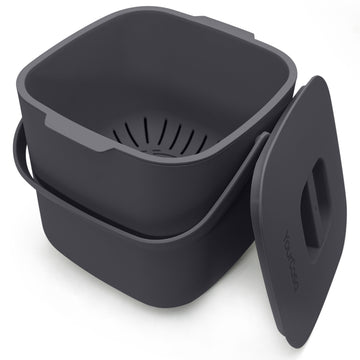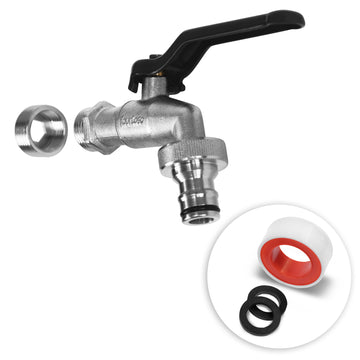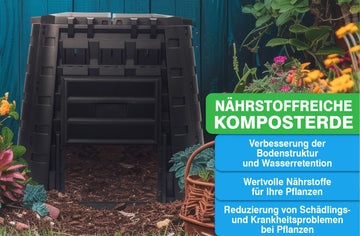
Winter - cold, snow and ice. Composting certainly can't work then, can it? The answer is: yes it can! You can compost in winter too , and composting plays an important role in the ecological cycle during this time of year too. Over the winter, the compost has plenty of time to decompose - and is ready for use in the spring.
This is important for your soil because ongoing composting significantly improves soil structure and quality . Healthy soil, in turn, promotes plant growth by providing them with necessary nutrients and supporting a robust root system.
What should you bear in mind when composting in winter? If you are composting in winter, it is especially important to protect the compost heap from extreme cold so that the decomposition process does not come to a halt. Cover your compost heap or container with an insulating layer, such as straw or leaves, to keep the heat inside the heap. It is also advisable to mix the compost regularly to ensure sufficient oxygen supply and promote decomposition. Also make sure that the compost does not get too wet to ensure good ventilation and prevent rotting processes.
Challenges of composting in winter
Winter brings with it a number of challenges . We humans have experienced this much more in the past, but it is still true today. The microbes and other creatures in your compost can also experience problems in the cold season, primarily due to low temperatures, snow and frost. These weather conditions can significantly slow down the composting process, as the activity of the microorganisms responsible for breaking down organic materials decreases in cold weather. Frost can even cause the compost pile to freeze through and the decomposition process to come to a temporary halt.
In addition, in winter, it may be harder for you to get a balanced mix of green and brown materials - this ensures a balanced nutrient content in the compost and is necessary for optimal composting. Green materials, such as kitchen scraps, are often plentiful and should never be thrown in the bin , but brown materials, such as dry leaves or wood chips, which provide carbon and are important for aerating the pile, can quickly become scarce.
Humidity fluctuations also cause further problems . Snow and ice can soak the compost. At the same time, severe frost can freeze the existing water in the compost, which reduces aeration and promotes anaerobic conditions. In the worst case, the latter can cause unpleasant odors in your compost and slow down the composting process.

Tips for successful composting in winter
As you can see, composting can be a challenge in winter . However, with good preparation, you can overcome most problems relatively easily. This way, you can ensure high-quality fertilizer for spring - with almost no work. We'll tell you how to do it.
Choosing the right composter
Not every composter is equally suitable for winter. In the following table you will find some variants that can withstand difficult weather conditions and produce valuable fertilizer even in the cold season.
| Composter type | Advantages | Disadvantages |
| Insulated composters | Provide protection from extreme temperatures and keep the heat inside better, which enables the composting process even in frost. | Can be more expensive and may require more space. |
| Worm bin | Take advantage of the natural warmth and activity of compost worms, which can remain active even in cooler temperatures. | Not suitable for very cold outdoor temperatures; worms need some warmth to survive. |
| Thermocomposter | Specially designed to retain heat and speed up the decomposition process through better insulation and sometimes even built-in heating elements. | Higher initial cost; requires regular monitoring and maintenance. |
Selection of location
Almost as important as choosing the right composter model is choosing a suitable location for your composter. A sheltered location helps protect the compost heap from extreme weather conditions. These include severe frost and excessive snowfall. These can hinder or even stop the composting process. You've probably noticed that the windows of your car don't freeze as easily if you park it close to a house wall. This is because buildings radiate heat. An ideal location is therefore close to a house wall. This also protects against snow and wind. This can prevent the compost heap from freezing through.
Trees can also act as natural wind and frost protection – and fallen leaves provide an additional layer of insulation that helps keep the temperature in the composter more stable. Make sure the location is not too shady, though. It tends to be colder in the shade – and warming rays of sun help to fuel the composting process.
Optimization of compost material
The next crucial point: the compost material. Choosing the right materials is essential to keep the composting process going even at low temperatures. Carbon-rich materials, such as dry leaves and twigs, play a key role here, as they not only support the necessary ventilation, but also help to retain heat in the compost heap or garden composter . But green, nitrogen-rich materials such as kitchen waste are also essential - these are best collected in a kitchen composter from YourCasa.
Here is an overview of different compost materials and their properties:
| Compost material | Advantages | Disadvantages |
| Dry leaves | Add carbon, which is important for aeration and heat retention of the compost pile. | In large quantities, they can hinder air circulation if not layered properly. |
| Twigs and branches | Improve the structure and promote air circulation in the compost heap. | Must be cut into small pieces to enable effective composting. |
| Kitchen waste | Provide important nitrogen and moisture, which serve as food for microorganisms. | If used in excess, they can cause odors and attract pests. |
| Paper and cardboard | A good carbon source that is readily available and supports moisture regulation. | Must be torn into small pieces to promote rapid decomposition. |
Regulate humidity and temperature
During the summer , the humidity and temperature in the compost are more or less regulated on their own. In the winter, however, you will have to put in a little more work. This is immensely important to maintain the composting process. One of the most effective ways to control these parameters is to regularly mix the compost pile. This promotes aeration and helps to avoid cold and damp spots in the pile, which can slow down the decomposition of the organic materials.
For additional insulation and temperature regulation, natural materials such as straw or leaves are great. These materials can be placed around and on top of the compost pile to retain heat inside and protect the pile from too much cold. Straw is particularly useful as it not only insulates but also helps air circulate within the compost - effectively preventing over-moisture. Leaves are not only easily accessible and cost-effective, but also serve as an additional source of carbon.
Hibernation of compost organisms
In winter, the microorganisms responsible for decomposition in compost slow down their activity due to the lower temperatures. This means that the composting process is slower, but by no means stops completely. The natural decomposition processes continue, albeit at a reduced pace. If you have always been interested in which organisms these are, we have an overview for you:
| name | Task | How to keep alive |
| bacteria | Decompose organic materials quickly. | Through sufficient moisture and ventilation. |
| Mushrooms | Degrade lignin- and cellulosic materials. | Keep the pile airy and moist. |
| Actinomycetes | Decompose hard, woody materials. | Ensure adequate ventilation and moisture inside the compost heap. |
| Protozoa | Help make nutrients available to plants. | Keep the compost moist and well mixed. |
| Invertebrates (e.g. earthworms, woodlice) | Aerate the compost and promote decomposition through their movement. | Make sure the moisture content is balanced and the material structure is not too dense. |
Back to the topic, it is important to understand that this slowdown is a natural part of the cyclical nature of composting. However, the cold season does not affect the long-term effectiveness of the resulting compost. As soon as temperatures rise in spring, the microorganisms quickly come alive again and resume their activities at full speed.

Conclusion
You see, finding solutions is not too difficult, even in winter. Even though composting is definitely easier in the three warmer seasons, you don't have to forego the production of valuable fertilizer for your garden in winter . With a few tricks, you can create a comfortable environment for the helpful microorganisms in your household and garden waste.
With our tips and the composters from YourCasa, it is quite realistic that you can keep the composting process alive even over the winter.

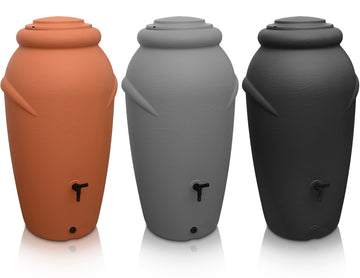
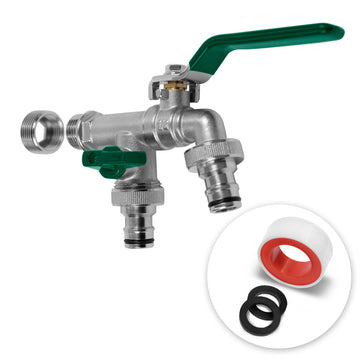
![Drei hohe YourCasa Regentonne 240 Liter [Wellen-Design] - Frostsicher & UV-beständige Gartentöpfe in den Farben Schwarz, Grau und Terrakotta, jeweils mit Drainagesystem für nachhaltige Bewässerung.](http://yourcasa.de/cdn/shop/files/ohnelogo_b8aeecac-557e-4106-a999-e77dcd160209.jpg?v=1707130230&width=360)
